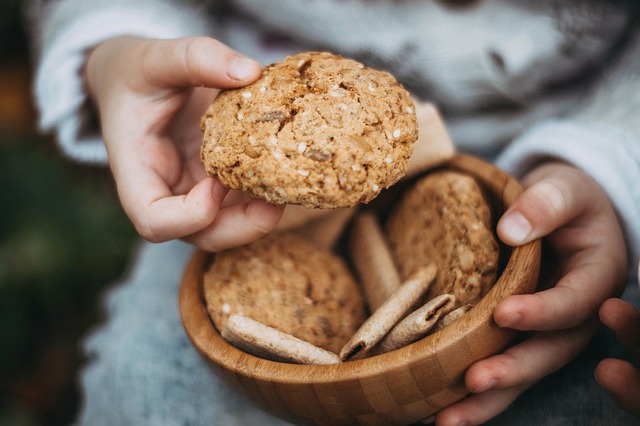Are you trying to convert to a diet of traditional foods? It can be hard to give up your favorite recipes.
But what if you didn’t have to? What if you could convert almost all of your “tried and true” recipes into soaked grain recipes?
You can! And I’ll show you how.
But first, you may want to read up on why it’s important to soak your grains.
How to Convert Your Recipes to Soaked Grain Recipes
I’ve been using this method for several months now, and I’ve posted a couple of my converted recipes here on the blog.
Recipes I’ve converted using this method:
But I must issue a small disclaimer:
This is a method that may or may not work with all recipes. Some recipes do take trial and error to convert. I will attempt to explain which recipes work best for converting to soaked grain recipes. Your mileage may vary.
That being said, I have had great success with this method. The easiest kinds of recipes to convert are recipes with a “batter” such as quick breads, muffins, waffles, pancakes, etc.
The thicker the batter or dough of the recipe, the more difficult it may be to convert to a soaked grain recipe and maintain the right consistency, but it can still be done.
You will need to determine what you are comfortable trying.
For instance, I have converted a bread recipe, and it turns out most of the time, but it’s a little tricky, especially for someone who is new to making bread.
So, let’s look at the steps. I will be using my Soaked Banana Bread recipe as an example.
1. Determine Your Soaking Ingredients
The first thing that you will need to do is determine which ingredients need to be soaked, and which ingredients will aid in the soaking process.
Ingredients that need to be soaked:
- Wheat
- Rye
- Barley
- Buckweat
- Some Nuts
“Corn, millet, oats, and rice are not high in phytase so soaking these grains does not make as much of a difference.”
Read more: To Soak or Not to Soak?
Ingredients that may aid in soaking are the “wet” ingredients. Anything that you determine can be safely left to sit at room temperature or warmer for 12-14 hours or so.
The more wet ingredients the recipe has that you can use in the soaking process, the better.
Wet ingredients that are good for soaking:
- Water
- Milk (raw is preferable)
- Eggs (fresh and pastured are preferable)
- Butter or oil
- Applesauce (can be used in place of butter/oil in many recipes)
- Fruit
- Sugar, honey, stevia, or maple syrup
Take a look at your particular recipe, and determine the ingredients you have to work with.
Example:
Using the example of my soaked banana bread, I determined that the whole wheat flour and nuts needed to be soaked. I also decided to use these ingredients for soaking: eggs, banana, sugar, and applesauce.
2. Pick an Acid Medium
The next thing you will need to do is determine an acid medium to add to your recipe while soaking. This ingredient will aid in breaking down the phytic acid in the grains.
You will need to add 1-2 Tbsp of whatever acidic ingredient you choose.
Acid mediums include:
- Whey
- Yogurt
- Kefir
- Kombucha
- Vinegar
- Lemon Juice
The acidic ingredient you choose can have an impact on the taste of your finished recipe, so choose carefully.
For instance, you may not want to choose vinegar for banana bread. Lemon juice may give it a lemon flavor, which can be nice if you enjoy the taste.
There is some debate over whether or not dairy mediums such as whey and yogurt can effectively break down the phytic acid in grains. I use it, but be aware of the controversy.
Example:
I determined that the bananas and applesauce in my banana bread recipe would be acidic enough to break down the phytic acid.
3. Soak Overnight
Once you have determined your soaking ingredients, it’s time to mix them together.
Tips for soaking:
- Use warm water, milk, oil, and other liquids when possible. 115 degrees is ideal.
- Use a non-reactive container for soaking such as a glass bowl.
- Cover the bowl with a towel and secure with a rubber band.
- Do not soak yeast, baking soda, baking powder, etc. These ingredients will not perform their job properly if soaked. Add these ingredients after soaking.
Most grains should be soaked for at least 12 hours. The easiest way to do this is to prepare the soaking ingredients the evening before and soak them overnight.
4. Prepare As Directed
Good job! Now that you’ve successfully soaked your grains, it’s time to add the rest of the ingredients for your recipe and prepare it as usual.
Remember, you have created an altered recipe. It will not be exactly the same as the original recipe. Cooking/baking times may be slightly shorter or longer depending on the recipe.
Suggested Reading: Nourishing Traditions – The cookbook that challenges politically correct nutrition and the diet dictocrats.
~
What recipes are you hoping to convert?


What a great post! I love this. I will be sharing this on facebook. It’s always fun to try to “convert” old recipes to be healthier and to try a soaked version, these are some great tips for doing that successfully, thanks so much.
~Hannah
I”m so glad you liked it. Thanks for stopping by and thanks for sharing!
I am experimenting with a soaked brownie recipe at the moment: challenge… no liquids. I am going to use coconut oil, pastured organic eggs, water and lemon.. i prefer the acidity of lemon per Ramiel Nagels suggestion.. and use a bit extra flour than the original recipe calls for.. to make up for the moisure and then …. we shall see!
Thanks for your great website…. kindred spirit.. stephanie
Stephanie, wish you luck! I have tried a brownie recipe once but just couldn’t get it to work.
Hey! I love this, such a good idea. I’ve been experimenting with converting recipes myself over the years. Say, above you have a quote that states that oats aren’t needed to be soaked as they are low in Phytates. I’m wondering your source for this info because I have many sources that state the exact opposite. One such source is Sally Fallons Nourishing Traditions. Page 453 states “those containing gluten, such as oats, rye, barely and especially wheat, should not be consumed unless they have been soaked or fermented…”
Promise I’m just trying to make sure that both of have the most accurate information! I don’t want anybody to be consuming Phytates especially if we’re going through all this extra work NOT to!!